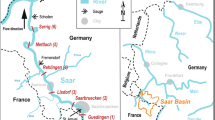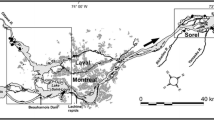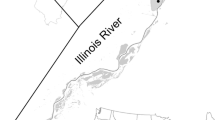Abstract
In the last 150 years, the Lower Mississippi River (LMR) floodplain was extensively reduced in area with conversion of once regularly inundated floodplain wetlands to dry land. Yet, between the present levees, there remain substantial remnants of the historical floodplain, including various types of permanent backwater habitats. We hypothesized that degree and timing of hydrologic connection with the river main channel drives variation in physical and chemical properties, and phytoplankton community dynamics, in backwaters. Over 23 months, measurements were made in several sites varying in connection with the main channel. At high stages, the channel and backwaters converged in having elevated turbidity, suspended solids and dissolved nutrient concentrations, reduced algal biomass and production, a seston C:N ratio indicating predominantly allochthonous organic matter sources, and a diatom-dominated community. When connection was reduced, backwaters declined in suspended sediments and nutrients, surged in production and biomass, had a seston C:N ratio reflecting autochthonous production, and switched to a community dominated by cryptomonad algae. With prolonged isolation, biomass-specific production became nitrogen limited and declined. By a conceptual model, we illustrate the seasonally variable role of permanent floodplain backwaters as major sources of algal organic matter, and potentially for nutrient sequestration, within the Lower Mississippi system.







Similar content being viewed by others
References
Amoros, C. & G. Bornette, 2002. Connectivity and biocomplexity in water bodies of river floodplains. Freshwater Biology 47: 761–776.
Arthington, A. H., 2012. Environmental flows: Saving rivers in the third millennium. University of California Press, Berkeley.
Babin, M., A. Morel & R. Gagnon, 1994. An incubator designed for extensive and sensitive measurements of phytoplankton photosynthetic parameters. Limnology and Oceanography 39: 694–702.
Baker, J. A., J. Killgore & R. L. Kasul, 1991. Aquatic habitats and fish communities in the lower Mississippi River. Aquatic Sciences 3: 313–353.
Bondar-Kunze, E., S. Preiner, F. Schiemer, G. Weigeljofer & T. Hein, 2009. Effect of enhanced water exchange on ecosystem functions in backwaters of an urban floodplain. Aquatic Sciences 71: 437–447.
Bunn, S. E. & A. H. Arthington, 2002. Basic principles and ecological consequences of altered flow regimes for aquatic biodiversity. Environmental Management 30: 492–507.
Chetelat, J., F. R. Pick & P. B. Hamilton, 2006. Potamoplankton size structure and taxonomic composition: Influence of river size and nutrient concentrations. Limnology and Oceanography 51: 681–689.
Cloern, J. E., 2007. Habitat connectivity and ecosystem productivity: Implication from a simple model. The American Naturalist 169: 21–33.
Delong, M. D. & J. H. Thorp, 2006. Significance of instream autotrophs in trophic dynamics of the Upper Mississippi River. Oecologia 147: 76–85.
Forshay, K. J. & E. H. Stanley, 2005. Rapid nitrate loss and denitrification in a temperate river floodplain. Biogeochemistry 75: 43–64.
Fremling, C. R., J. L. Rasmussen, R. E. Sparks, S. P. Cobb, C. F. Bryan & T. O. Claflin, 1989. Mississippi River fisheries: a case history. In Dodge, D. P. (ed.), Proceedings of the International Large River Symposium. Canadian Special Publication of Fisheries and Aquatic Sciences 106: 309–351.
Gabellone, N. A., L. C. Solari & M. C. Claps, 2001. Planktonic and physic-chemical dynamics of a markedly fluctuating backwater pond associated with a lowland river (Salado River, Buenos Aires, Argentina). Lake and Reservoirs: Research and Management 6: 133–142.
Galat, D. L., L. H. Fredrickson, D. D. Humburg, K. J. Bataille, J. R. Bodie, J. Dohrenwend, G. T. Gelwicks, J. E. Havel, D. L. Helmers, J. B. Hooker, J. R. Jones, M. F. Knowlton, J. Kubisiak, J. Mazourek, A. C. McColpin, R. B. Renken & R. D. Semlitsch, 1998. Flooding to restore connectivity of regulated, large-river wetlands. Bioscience 48: 721–733.
Gallegos, C. L., 1992. Phytoplankton photosynthesis, productivity, and species composition in a eutrophic estuary: Comparison of bloom and non-bloom assemblages. Marine Ecology Progress Series 81: 257–267.
Garcià de Emiliani, M. O., 1993. Seasonal succession of phytoplankton in a lake of the Paranà river floodplain, Argentina. Hydrobiologia 264: 1517–1573.
Gore, J. A. & F. D. Shields, 1995. Can large rivers be restored? BioScience 45: 142–152.
Gotelli, N. J. & A. M. Ellison, 2004. A Primer of Ecological Statistics. Sinauer Associates, Sunderland, MA.
Gumiero, B., J. Mant, T. Hein, J. Elso & B. Boz, 2013. Linking the restoration of rivers and riparian zones/wetlands in Europe: Sharing knowledge though case studies. Ecological Engineering 56: 36–50.
Hein, T., G. Heiler, D. Pennetzdorfer, P. Riedler, M. Schageri & F. Schiemer, 1999. The Danube restoration project: Functional aspects and planktonic productivity in the floodplain system. River Research and Applications 15: 259–270.
Hein, T., C. Baranyi, G. J. Herndl, W. Wanek & F. Schiemer, 2003. Allochthonous and autochthonous particulate organic matter in floodplains of the River Danube: The importance of hydrological connectivity. Freshwater Biology 48: 220–232.
Hein, T., C. Baranyi, W. Reckendorfer & F. Schiemer, 2004. The impact of surface water exchange on the nutrient and particle dynamics in side-arms along the River Danube, Austria. Science of the Total Environment 328: 207–218.
Hein, T., W. Reckendorfer, J. Thorp & F. Schiemer, 2005. The role of slackwater areas and the hydrologic exchange for biogeochemical processes in river corridors: Examples from the Austrian Danube. Archiv für Hydrobiologie 155: 425–442.
Huszar, V. M. & C. S. Reynolds, 1997. Phytoplankton periodicity and sequences of dominance in an Amazonian flood-plain lake (Lago Batata, Parà): Responses to gradual environmental change. Hydrobiologia 346: 169–181.
Jassby, A. D. & T. Platt, 1976. Mathematical formulation of the relationship between photosynthesis and light for phytoplankton. Limnology and Oceanography 21: 540–547.
Junk, W. J. & K. M. Wantzen, 2004. The flood pulse concept: New aspects, approaches, and applications—An update. In Welcomme, R. & T. Petr (eds), Proceedings of the 2nd Large River Symposium (LARS), Pnom Penh. RAP Publication, Cambodia, Bangkok: 117–149.
Junk, W. J., P. B. Bayley & R. E. Sparks, 1989. The flood pulse concept in river-floodplain systems. In Dodge, D. P. (ed.), Proceedings of the International Large River Symposium. Canadian Special Publication of Fisheries and Aquatic Sciences 106: 110–127.
Kendall, C., S. R. Silva & V. J. Kelly, 2001. Carbon and nitrogen isotopic compositions of particulate organic matter in four large river systems across the United States. Hydrological Processes 15: 1301–1346.
Knowlton, M. F. & J. R. Jones, 1997. Trophic status of Missouri River floodplain lakes in relation to basin type and connectivity. Wetlands 17: 468–475.
Köhler, J., 1994. Origin and succession of phytoplankton in a river-lake system (Spree, Germany). Hydrobiologia 289: 73–83.
Lewis, M. R. & J. C. Smith, 1983. A small volume, short incubation-time method for measurement of photosynthesis as a function of incident irradiance. Marine Ecology Progress Series 13: 99–102.
Martin Creuzburg, D., E. von Elert & K. H. Hoffmann, 2008. Nutritional constraints at the cyanobacteria Daphnia magna interface: The role of sterols. Limnology and Oceanography 53: 456–468.
Miranda, L. E., 2005. Fish assemblages in oxbow lakes relative to connectivity with the Mississippi River. Transactions of the American Fisheries Society 134: 1480–1489.
Mitsch, W. J. & J. W. Day Jr, 2006. Restoration of wetlands in the Mississippi–Ohio–Missouri (MOM) River Basin: Experience and needed research. Ecological Engineering 26: 55–69.
Morris, C., 2012. The Big Muddy: An Environmental History of the Mississippi and its Peoples from Hernando de Soto to Hurricane Katrina. Oxford University Press, Oxford.
Ochs, C. A., O. Pongruktham & P. V. Zimba, 2013. Darkness at the break of noon: Phytoplankton production in the Lower Mississippi River. Limnology and Oceanography 58: 555–568.
Poff, N. L., J. D. Allan, M. B. Bain, J. R. Karr, K. L. Prestegaard, B. D. Richter, R. E. Sparks & J. C. Sromberg, 1997. The natural flow regime: a paradigm for river conservation and restoration. Bioscience 47: 769–784.
Reynolds, C. S. & J.-P. Descy, 1996. The production, biomass and structure of phytoplankton in large rivers. Archiv für Hydrobiologie 113: 161–187.
Reynolds, C. S., V. Huszar, C. Kruk, L. Naselli-Flores & S. Melo, 2002. Towards a functional classification of the freshwater phytoplankton. Journal of Plankton Research 24: 417–428.
Richardson, W. B., E. A. Strauss, L. A. Bartsch, E. M. Monroe, J. C. Cavanaugh, L. Vingum & D. M. Soballe, 2004. Denitrification in the Upper Mississippi River: Rates, controls and contribution to nitrate flux. Canadian Journal of Fisheries and Aquatic Sciences 61: 1102–1112.
Ruskey, J. A., 2012 Rivergator. The Lower Mississippi water trail. http://www.rivergator.org/.
Sakshaug, E., A. Bricaud, Y. Dandonneau, P. G. Falkowski, D. A. Kiefer, L. Legendre, A. Morel, J. Parslow & M. Takahashi, 1997. Parameters of photosynthesis: Definitions, theory and interpretation results. Journal of Plankton Research 19: 1637–1670.
Schagerl, M., I. Drozdowski, D. G. Angeker, T. Hein & S. Preiner, 2009. Water age—a major factor controlling phytoplankton community structure in a reconnected dynamic floodplain (Danube, Regelsbrunn, Austria). Journal of Limnology 68: 274–287.
Tockner, K., D. Pennetzdorfer, N. Reiner, F. Schiemer & J. V. Ward, 1999. Hydrological connectivity and the exchange of organic matter and nutrients in a dynamic river-floodplain system (Danube, Austria). Freshwater Biology 41: 521–535.
Unrein, F., 2002. Changes in phytoplankton community along a transversal section of the Lower Paranà River, Argentina. Hydrobiologia 468: 123–134.
United States Army Corps of Engineers (USACE), 2007. 2007 Flood Control and Navigation Maps Mississippi River, Cairo, Illinois to the Gulf of Mexico, Mile 953 to mile 0 A.H.P., 62nd edition. Mississippi River Commission, U.S. Army Corps of Engineers.
Valett, H. M., M. A. Baker, J. A. Morrice, C. S. Crawford, M. C. Molles Jr, C. N. Dahm, D. L. Moyer, J. R. Thibault & L. M. Ellis, 2005. Biogeochemical and metabolic responses to the flood pulse in a semiarid floodplain. Ecology 86: 220–234.
Ward, J. V. & J. A. Stanford, 1995. Ecological connectivity in alluvial river ecosystems and its disruption by flow regulation. Regulated Rivers: Research and Management 11: 105–119.
Weers, P. M. M. & R. D. Gulati, 1997. Effects of the addition of polyunsaturated fatty acids to the diet on the growth and fecundity of Daphnia galeata. Freshwater Biology 38(721): 729.
Wehr, J. D. & R. G. Sheath, 2003. Freshwater Algae of North America: Ecology and Classification. Academic Press, San Diego, CA.
Wetzel, R. G. & G. E. Likens, 2000. Limnological Analyses, 3rd ed. Springer, New York, NY.
Acknowledgments
We are grateful to B. Munxayaphom for assistance in the field and in the lab. We thank H. Capello, and J. Ruskey who facilitated initiation of the study. L. Brooks, J. Hill, S. Knight, M. Moore, S. Morgan, L. Summerhill, and S. Testa provided critical technical assistance. Insightful comments on earlier versions of this manuscript were provided by S. Brewer, M. Jekabsons, J. Murdock, D. Nagle, D. Reed, F.D. Shields, and P. Zimba. Funding for this study was provided by The University of Mississippi Graduate Student Council and UM Graduate School.
Author information
Authors and Affiliations
Corresponding author
Additional information
Handling editor: Nicholas R. Bond
Rights and permissions
About this article
Cite this article
Pongruktham, O., Ochs, C. The rise and fall of the Lower Mississippi: effects of hydrologic connection on floodplain backwaters. Hydrobiologia 742, 169–183 (2015). https://doi.org/10.1007/s10750-014-1983-5
Received:
Revised:
Accepted:
Published:
Issue Date:
DOI: https://doi.org/10.1007/s10750-014-1983-5




